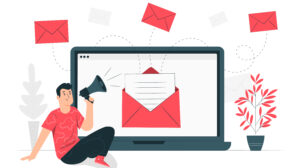Research shows that editors prefer to receive follow up emails 1 week after a pitch is sent…. But with the majority of editors receiving up to 10 pitches per day (and therefore 10 follow ups per day!), how can you make sure that YOUR follow up email is one that editors will want to open and respond to?
The answer: Be different.
One of the worst things you can do is Google ‘follow up email template’. Why? Because all you’re doing is filling your prospect’s inbox with a generic, standardized email that they will have seen a million times.
Yawn.
Boring.
What’s for dinner?
The mundane is practical, sure, but it isn’t interesting; it isn’t attention grabbing. It’s time to turn heads.
Stand Out From the Crowd
Learning how to stand out in a noisy world isn’t always easy. There are so many methods and techniques that we’ve used so frequently that they’ve practically become ingrained into our day-to-day processes.
Making a change can be daunting, but by putting new formats, new ideas, and new ways of forming relationships out there, you could significantly increase response rates to your follow up emails.
So just what are some new ideas for follow up emails? Let’s take a look at 10 possibilities:
1. The Honest Follow Up
We want editors to like us. We want to suck up. We want to spew compliments. We want to go all 1980’s Sally Field on them and scream ‘you like me, you really like me!’. But guess what. No one likes a kiss ass.
We have found that nearly two thirds of editors hate cheesy pickup lines. It’s not a date. Editors don’t want admirers. They want people bold enough to share their own ideas.
Take the ‘honesty is the best policy’ approach in your follow up email. Don’t agree with something you’ve seen posted? Think a post is badly written? Call them out on it, and show them how you can help.
Examples:
- I’m such a big fan of your blog! I’ve been following it religiously for years and I think it’s absolutely perfect. I’d really love it if you could give me a chance to contribute. (Barf!)
- I’ve noticed that one of your recent guest posts, titled X, has a few mistakes in it. I just wanted to point this out as fact checking is important to me; I believe it really adds credibility to content.
2. The Visual Follow Up
Do you know what editors don’t want to see at the end of a long day? A massive wall of text. Do you know what they DO want? A little visual stimulation that brings a smile to their face (even on a Monday!)
Believe it or not, most editors don’t mind if you use gifs or memes in your follow up email… as long as they’re relevant and not too crude of course. It maybe best to step away from the poop emojis….
There’s a New York Times Bestseller called Yes! 50 Scientifically Proven Ways to be Persuasive (well worth a read) which shows that a funny, inoffensive cartoon in communications can really boost levels of trust.
Example:
- I sent you my pitch because I believe content marketing is more important than ever before.
3. The Thoughtful Follow Up
If you don’t have a reason to get back in touch with an editor other than to remind them of your pitch and do the tail-between-the-legs ‘just checking in’ thing, then make a reason. Pull one out of thin air.
Have you seen a news item that’s relevant to their readership? A picture? Travelled somewhere that made you think of the website, the editor, or their audience? Anything at all? Then use it!
Remember that personalization is one thing, but thoughtfulness is quite another. Make the editor know that, even though they haven’t yet been in touch, you are still thinking about how you can help them.
Examples:
- Just checking in to see if you’ve read my pitch about pizzas yet for your recipe site?
- I saw this video today about pizzas and it made me think of you. I know your audience love your pizza recipes (which is why I pitched you some ideas recently!). It’s a great watch; Enjoy!
4. The Understanding Follow Up
Let’s not beat around the bush here; receiving cold emails is annoying. More annoying than forgetting to switch on the crock pot before work and coming home to a bowl of cold, pretty off-smelling chicken.
Sure, if you’re trying to expand your online reach and target new demographics then you gotta do what you gotta do. But it doesn’t hurt to resonate and acknowledge the editor’s potential frustration.
This can actually be hugely beneficial. It shows that you understand things from the editor’s point of view; that you can recognize other perspectives and put yourself in other people’s (audience’s) shoes.
Examples:
- Do you like my pitch? I think it’s really great and you’ll definitely want to learn more.
- Look, I know it sucks receiving these emails (believe me, it pains me to press the send button) but I really think my ideas would engage your readers and I don’t think we should give up easily!
5. The Well-Researched Follow Up
It’s not like you need to go full-on stalker mode here, but a little bit of (perfectly legal) snooping doesn’t hurt when it comes to follow up emails. So what is your editor up to that you could use to help you?
Try to keep up-to-date with what your editor is doing — Is he/she attending an event? Going travelling? Beginning a new partnership with an influencer? Working on a book? Use this to your advantage.
This information can add an even deeper level of personalization to your follow up email, showing the editor that you’ve really put the effort into creating the foundations of a long lasting relationship.
Examples:
- I know you’re busy, but I’m just checking if you’ve had chance to read my pitch yet?
- I know you’ve been busy attending the X exhibition in California, so I’m just re-sending my information so you can find it more easily when you have a little more time on your hands.
6. The Informative Follow Up
Rather than simply asking if an editor has had time to sit down and check out your pitch, give them an actual valuable reason to open your follow up email. If they’re clicking, it should be worth their time.
While a pitch email should be simple and direct, a follow up email can be a bit more flexible and you can get a bit more creative. Use this as another opportunity to sell yourself. Don’t waste a communication.
Adding additional information to your follow up email is a fine art. All vital information should have been included with your pitch, so think about other relevant aspects you could throw in to engage editors.
Examples:
- Just checking in to see if you’ve read my pitch. That’s all!
- I thought that learning a little more about me could help you to see if I’m the right fit for your readership. My first ever guest post was for X, and since then I’ve gone on to write for…
7. The Questioning Follow Up
Editors are busy people, sure. But in general they’re not rude people (unless you’re unlucky!). If you follow up with a question, any decent editor should take the time to respond. It’s basic politeness.
If an editor is taking the time to answer your question, then they may also take a moment to address your pitch. And if they don’t address your pitch, then you have your answer and you can proudly walk away.
The type of question you ask can be practically anything, as long as it’s relevant. You could be asking about a specific post that’s been published, about the website, or even checking contact details.
Examples:
- Just checking if you saw the pitch I sent to you last week?
- I sent some ideas across last week and realized I might be barking up the wrong tree here! Could you please confirm if you are the right contact to be sending pitches across to? Thanks!
8. The FOMO Follow Up
FOMO — fear of missing out — is very, very real. So show editors just what they’re missing. If things are going well, you should be having work published (even on your own website) pretty regularly by now.
If you’ve not had a response to your pitch, show the editor what could have been by sending a link to a recent article; one that is performing really well with audiences and is relevant to the editor’s readers.
We all want what we can’t have. By sending a FOMO follow up, you may just encourage the editor to get in touch to ensure that they’re given first refusal on your ideas and stop you taking them elsewhere.
Examples:
- I’ve written many articles on topics that I think would be relevant to your audience.
- I recently had an article published about pizza on X blog, which I think your readers would have loved. You can check it out here:
9. The Alternative Follow Up
No one agrees on who said it — Einstein, Franklin, Twain, or Rita next door — but we do know it was said: The definition of insanity is doing the same thing over and over and expecting different results.
If you’ve tried to get a response from an editor by email and it hasn’t worked, try something else. If email doesn’t work, go social (but stay away from the phone, no one wants to be put on the spot).
A quick Tweet or Facebook message can be great. Editors love this. It gives them a chance to sneakily check out your social voice and verify who you say you are before sending a response to your pitch.
Examples:
- (Via Email): I’m just dropping another email to see if you liked my pitch.
- (Via Twitter): Just a quick note to say I sent you some ideas by email last week, hope you enjoy.
10. The Non-Follow Up Follow Up
Whaaaat? Don’t follow up? Has everyone gone crazy? Maybe. Maybe not. Have you considered following up, but not with the same person? It sounds a little strange, but bear with us for a moment here….
Think about it. Life gets in the way. We all know that. Maybe an editor has had one hell of a week. Maybe they’re having computer problems. Maybe they don’t have the energy to respond to pitches right now.
Why not try someone else? Do some digging around to see if you can find another contact and reach out to someone else at the same blog or organisation. There’s no need to re-pitch, just say hello.
Examples:
- (To Original Contact): I’m just following up to see if you had a chance to read my pitch?
- (To New Contact): I sent across some ideas to John last week but I haven’t heard back yet. I know that life can get in the way sometimes, but I just want to make sure my pitch isn’t overlooked.
Same Strategy, Different Approach
All of these 10 new ideas for follow up emails are very distinct, yet they all have one thing in common. Each idea follows the classic cold calling strategy: ABCDE.
- Attract
- Bond
- Convert
- Deliver
- Endear
As long as your follow up email follows the ABCDE pattern, the world is your oyster. Be creative, dare to do something different, and stand out from the crowd.
It doesn’t matter how you ABCDE… as long as you do it!




